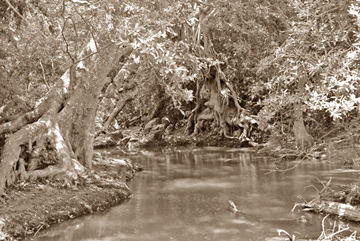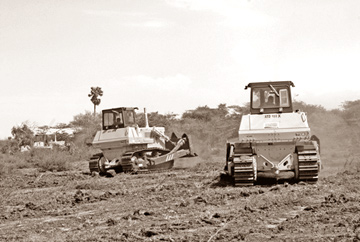The giant wakes up Revival of Yoda Wewa
Lionel Wijesiri
From early times, the economic potentials in the North had played a
vital role in strengthening Sri Lanka's national economy. Its landscape
is unique in character since the nature has endowed it with a rich soil
and most fertile paddy lands.
Mannar is one of the administrative districts of the North. In the
olden days, Mannar was famous for its port known as Mahaota, Mantota and
Mahatheetha in
|

Minister Chamal Rajapaksa inspects the progress with his
officials |
Sanskrit, (which means the 'great port'). The Malvatu-Oya (Aruvi Aru)
provided a direct water route from Mantota to the Ancient capital
Anuradhapura. It was the largest and most important port in the Indian
Ocean and traders from East Asia and Mediterranean were regular visitors
to this great port.
Yoda Wewa is situated about 25km southeast of Mannar. The origin of
this tank is not known. Some historians believe that it was built by
King Dhathusena (459-477) by damming the Malwatu-Oya. Some others
believe Nagas of ancient Sri Lanka built it. Mudaliyar C. Rajanayagam in
his book, Ancient Jaffna says, "The existence of the extensive ruins at
Manthai and of the celebrated Giant's tank close to it., are indubitable
signs of an immense population well advanced in agriculture. The giant's
tank must, therefore, have been the constructed probable by the ancient
Nagas, who were the people then living in the part of Ceylon". The port
was surrounded by villages with Naga names. e.g. Nagarkulam, Nagathazhvu
and Sirunagarkulam. According to Rajanayagam, a great Naga civilization
existed here long before the arrival of Sinhalese.
Whoever built the tank - Yoda Wewa is considered one of the earliest
and best ever constructed in the world, virtually a pioneer in tank
irrigation.
Dr. Ananda W.P. Guruge in 'The water lords of ancient Sri Lanka'
(UNESCO Courier, Jan, 1985) describes how even the modern European
Engineers could not understand the sophisticated systems adapted by our
forefathers in the construction of tanks. "Many a modern engineer has
been baffled by the sophisticated designs on which these reservoirs and
channel systems were constructed.
It is known that the Dutch engineers of the eighteenth Century and
their British counterparts in the nineteenth failed to understand the
design of the giant tank near Mannar on the northwestern coast. Only in
recent years, when the tank was restored in conformity with the original
design, was it found that leveling by the unknown engineer of the past
was vastly superior to that attempted by modern engineers."
There were two parallel lines of embankment towards the sea joined by
a flat curved bund. This makes the bund to enclose the tank on three
sides, making it possible to irrigate the land on both flanks as well as
the land in front. British engineers were confused but Brohier saw the
thinking behind it.
Rehabilitation
Mannar receives nearly 60 percent of its rainfall during the
northeast monsoon, which lasts from mid October through December. Our
ancestors would have constructed Yoda Wewa to retain water as much as
possible so that it could feed 162 minor tanks dotted round a vast area
in the district. It is an unique concept not seen in any other major
tank in Sri Lanka.
|

Environmental friendly surroundings. |
|

Area being cleared for harvesting. |
|

Completing the Yoda Wewa dam. |
The total capacity of the tank is 31,500 acre feet and the water from
this tank is fed to 162 smaller tanks downstream and irrigates about
11,000 hectares of paddy land. At the end of the monsoon season, excess
water is stored in a tank upstream (Tekkam Anicut) and used to irrigate
an additional 2,500 ha. Yoda Wewa directly benefits 2,500 farm families.
For almost three decades parts of this tank was under LTTE terrorists
and the maintenance was neglected due to security reasons. When Sri
Lankan Forces liberated the area last year, the restoration of the tank
began. Among others, the rehabilitation of paddy lands in Musali,
Silavathura, Nochchikulam, Ranketh Wewa and Nochchikotai and the
development of the surrounding infrastructure facilities began to
progress rapidly.
A group of journalists and writers were recently given the
opportunity of visiting the vicinity of Yoda Wewa to witness themselves
the progress made in the provision of irrigation facilities for the
returnees.
They were shown how the repair and reconstruction of Yoda Wewa bund
is nearing completion and progress made in the clearance of land to be
made suitable for cultivation of crops. Ports, Aviation and Irrigation
Minister Chamal Rajapaksa also visited the area and met groups of
farmers to discuss their problems at site. Later, representatives of
Farmer associations met him on a 'Janahamuwa' and discussed the present
and future plans for the area.
By looking at the activities happening, it is obvious that the
Government wants to resettle the war displaced people back in their own
lands and in Mannar District, most of them are farmers.
Their incomes are based on producing paddy or other agriculture-based
products. On the instructions of Ports, Aviation and Irrigation Minister
Chamal Rajapaksa, a master plan had been drafted to revive the two
partly abandoned major irrigation tanks (Yoda Wewa and Akatthinuruppu
tank) at a cost of Rs. 635 million.
The cost of rehabilitation of Yoda Wewa itself cost Rs. 385 million.
It is estimated that 25,000 acres of land could be cultivated
benefitting 7,000 farmer families when both tanks are rehabilitated and
as soon as the resettlement process begins, sufficient water will be
ready for the families who return back to their own lands.
It is heartening to note that the Government has fully understood
that development of an irrigation system is a crucial element in the
social organization and cultural traditions.
It not only sustains farmers, but also creates new floral and faunal
communities. For instance, the vicinity of Yoda Wewa has also been
identified as an IBA (Important Bird Area) by BirdLife International.
Large flocks can be found here of both resident and migrant aquatic
birds.
Working hard
In Musali, I spoke with few returnees. They were all unanimous in
expressing their joy at the change in their fortunes. One farmer said,
"In the 1990, 90 percent of the population of Musali was Muslim. That
year, the LTTE came and told us to leave the area within 24 hours.
We were allowed to take away only our clothes. I went to Puttalam. I
had a shop in town and a generator at home. Today, I don't have
anything, not even my house. But I am happy to be back. I will work hard
and build up my life with my family. What we ask is only water. We are
grateful to the Government for what they are doing for us."
We also met the Irrigation Engineer, M. H. C. K. Silva. In his
administrative area, there are 4,538 acres of irrigable land.
He said that 3,000 acres of them could be cultivated in the coming
Maha season. His area consists of 23 small tanks which are connected to
the Yoda Wewa for water. He also spoke about the resettlement program
and said that the Government is giving heavy subsidies to the returnees
and also support for their livelihood plans. There is a large increase
in the influx of returnees during the past few weeks.
There is no doubt that agriculture - the main economic activity of
the people of Mannar District will receive an impetus with the
Government's rehabilitation programs in the forthcoming Maha crop season
with the North East monsoon expected a few weeks from now.
On my way back to Colombo, a few words spoken by a middle-aged
returnee reverberated in my mind.
"No matter my home is torn down, no matter I have no household
furniture or anything tangible, it gives me a different high, and I'm
thrilled about coming back to where I belong. We will revive to normalcy
in no time." The message he tries to give us is loud and clear.
(Grateful thanks to Irrigation and Water Management Ministry
Secretary Eng. Ivan de Silva for providing information and P. D. Ranjith
of the Information Department for supplying photographs) |



